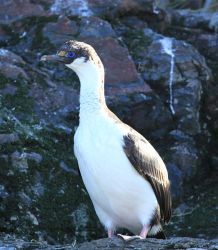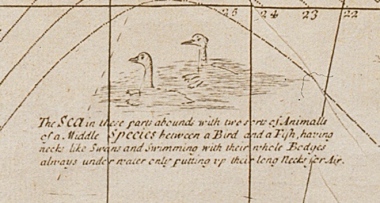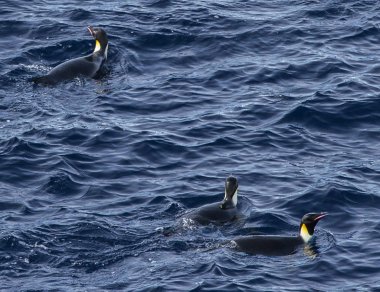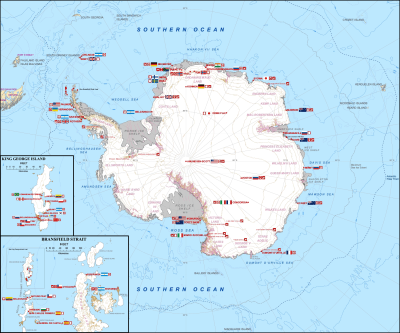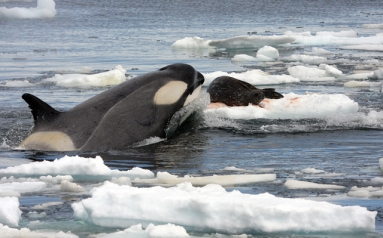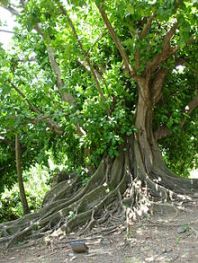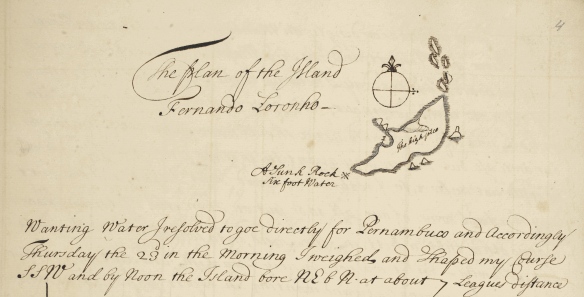Halley arrived back in Deptford from his second voyage on 10 September 1700 and he’ll return to sea for his third voyage in June 1701 (June 2015 by the life of this blog), so I thought I’d close this phase of my project by looking at some of the things that Edmond will be doing in the intervening months.
As we’ve seen (here and here), he began preparing his chart of magnetic variation as soon as he returned to London and there are periodic entries in the Royal Society minutes of his showing (what are assumed to be) manuscript drafts of his chart at their meetings. He presented a copy formally to the Society on 4 June 1701, when the minutes record:
Mr Halley presented the Society with a Map of his late Voiage to the South. He was thanked for it, & it was order’d to be hung in the Meeting room. [1]
The exact publication date of the chart isn’t known but is assumed to have been during the second quarter of 1701 (given its presentation date to the RS), and it occurs to me that a letter dated 6 May 1701 from the Admiralty to the Navy Board, awarding a bonus of £200 to Halley on the order of the king, may have been prompted by the publication of his chart:
In obedience to his Mats. [Majesty’s] Commands signified to this Board, Wee do hereby desire and direct you to cause to be paid unto Captn. Edward [sic] Halley, out of the Money in the hands of the Trea[sure]r of the Navy upon Acct. of the Tenths of Prizes the sum of two Hundred Pounds, in consideration of his great Paines and care in a late Voyage he made for the discovering the Variation of the Needle. [2]
Halley resumed his attendance at Royal Society meetings when they reconvened after their summer recess, and, having resigned his Fellowship in 1686 to become the Society’s clerk, he was re-elected FRS at the General Meeting of 30 November 1700 and voted one of the auditors of their accounts on December 17. [3]
Halley was often referred to as “Capt Halley” in the Society’s minutes of this period, but it’s somewhat surprising how few references there are to his voyage; I assume Edmond mostly talked about his expedition in the coffeehouses.
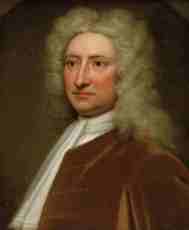
Halley, by Kneller (© NMM, BHC2734)
It was perhaps during this period that Halley had his portrait painted by Godfrey Kneller. The date of the portrait isn’t known, but has been estimated at around 20 years after his voyages because of a mezzotint version published after Halley became Astronomer Royal in 1720. However, Alan Cook says that Halley is wearing naval uniform and so suggests it may have been painted in 1702 after his third voyage, and this – or even 1701 – seems more likely to me, when Halley was famed for his voyages, and also because Halley appears younger in this portrait than in the one known to date before 1713. [4]
In between preparing his chart, attending Royal Society meetings, frequenting the coffeehouses, and perhaps having his portrait painted, Halley surely entertained his wife, Mary, and their three children with tales of adventures and of the people and animals he’d seen on his cruise. Perhaps he brought back curiosities as gifts for them?
I know he did bring back some items, and they’re partly what prompted me to speculate whether Halley had kept a private journal or notes during his voyage. Another reason is that one or both of his logs may initially have been written on loose pieces of paper and then written up later (and there is some doubt in my mind whether the fair copies were actually written up by his clerk(s)). I hope to do more research on the history of his logbooks and will perhaps write more about this at the end of his third voyage.
A further reason for my speculation is that there are extant papers besides his logbook surviving from the second voyage – namely, a series of sketches of fish! He presented these drawings (made by himself) to the Royal Society on 6 November 1700, along with some sketches of the Batavian Islands; the sketches of the Islands are seemingly lost but five sketches* of fish are safely stored in the Society’s archives and here’s perhaps the best of the set, with text written by Halley:
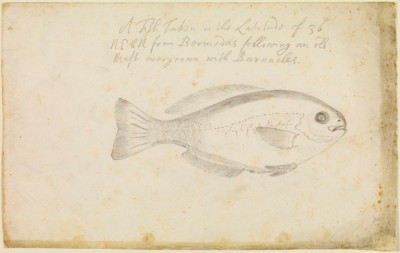
“A Fish Taken in the Latitude of 36° NEbN from Bermodas following an old Mast overgrown with Barnacles.” (© Royal Society, RS.9360)
It was a great pleasure to see the originals in the Society’s library; they are more impressive ‘in the flesh’, and I particularly liked that they gave me a palpable sense of Edmond sitting down in his cabin and carefully sketching the fish on the table before him (you can really sense him at work on the fish’s scales towards the tail). The drawings may not display the talent of Hooke or Waller, but their ordinariness somehow serves to evoke the physical presence of Halley the man.
And so, having conjured his presence, we’ll leave him be for a while. His third voyage will start in June next year (2015 for us), and I’ll be back then to conclude this project to bring astronomer Edmond Halley’s seafaring adventures to wider attention.
* I couldn’t link to the page showing all the fish, so here are the individual links to the other four: Doctor fish, Tuna fish, Pilot fish, Flying fish. If only there’d been a sketch of his birds!
_______________
[1] Royal Society, JBO/10 p 219.
[2] National Archives, ADM 2/181 p125.
[3] Royal Society, JBO/10 pp 204 and 206.
[4] Cook, Edmond Halley: Charting the Heavens and the Seas (Oxford, 1998) p xv.


